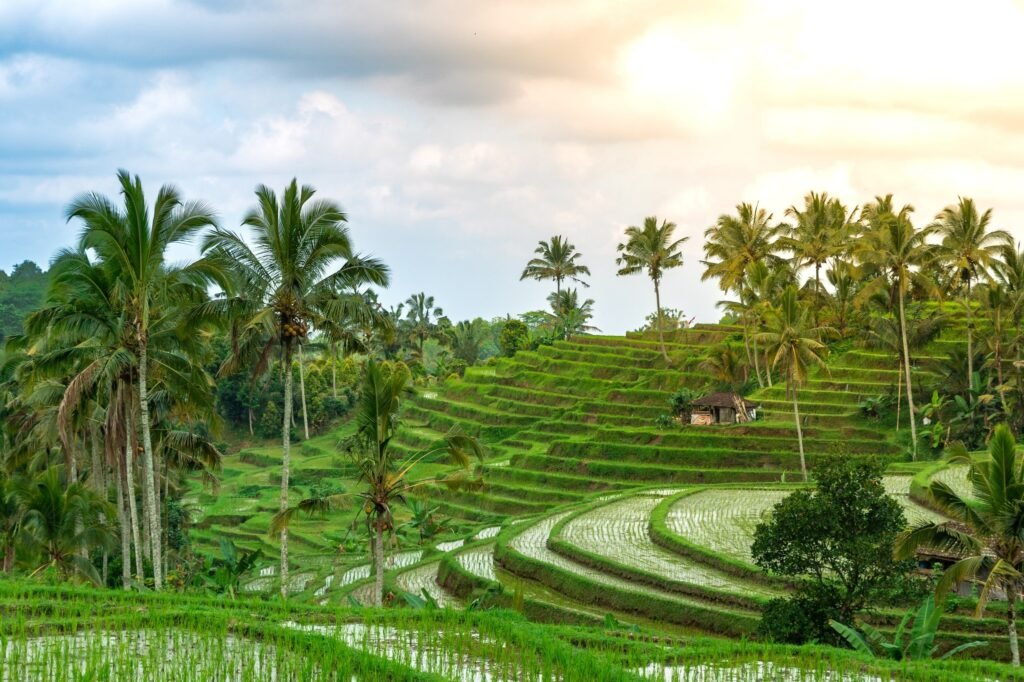Where Ancient Traditions Meet Modern Paradise

The scent of frangipani flowers drifts through the humid air as the sun sets over emerald rice terraces, casting golden shadows across stone temples that have stood for centuries. This is Bali—Indonesia’s crown jewel, where spirituality and natural beauty converge in perfect harmony.
Bali isn’t just a destination; it’s a living, breathing work of art. The island’s 4.3 million inhabitants have maintained their Hindu-Balinese traditions with remarkable devotion, creating a unique cultural landscape that sets it apart from the rest of predominantly Muslim Indonesia. Every morning, the air fills with the sweet smoke of incense as locals place colorful penjor (bamboo decorations) and intricate flower offerings called canang sari at temple doorsteps, shops, and even on car dashboards.
The island’s artistic heritage runs deep through every village. In Ubud, the cultural heart of Bali, master woodcarvers shape intricate Garuda birds and dancing figures from hibiscus wood, while silver artisans in Celuk village hammer delicate jewelry using techniques passed down through generations. The village of Mas is renowned for its mask-making traditions, where skilled craftsmen create elaborate topeng masks used in traditional dance performances.

Bali’s landscape is punctuated by over 20,000 temples, each more breathtaking than the last. The majestic Tanah Lot temple perches dramatically on a rock formation in the sea, accessible only at low tide, while the cliffside Uluwatu temple offers spectacular sunset views over the Indian Ocean. But perhaps none is more iconic than the “Gates of Heaven” at Pura Lempuyang, where visitors queue for hours to capture the perfect photograph with Mount Agung framed in the temple’s ornate doorway.
The mother temple of Besakih, known as the “Mother of All Temples,” sits on the slopes of Mount Agung, Bali’s highest peak. This complex of 23 separate temples represents the spiritual epicenter of the island, where major Hindu ceremonies take place throughout the year.

The UNESCO World Heritage-listed Jatiluwih rice terraces showcase Bali’s ingenious subak irrigation system, a traditional method of water management that has sustained the island’s agriculture for over 1,000 years. These emerald-green steps cascade down hillsides like nature’s own amphitheater, changing color with the seasons from brilliant green during growing season to golden yellow at harvest time.
Beyond the rice fields, Bali offers diverse natural experiences. The active volcano Mount Batur provides adventurous travelers with sunrise trekking opportunities, while the pristine beaches of the Bukit Peninsula offer world-class surfing at breaks like Uluwatu and Padang Padang. The island’s interior harbors hidden waterfalls like Sekumpul and Tegenungan, where visitors can swim in crystal-clear pools surrounded by lush tropical vegetation.

In recent years, Bali has emerged as a global wellness destination, attracting yoga practitioners, meditation enthusiasts, and health-conscious travelers from around the world. Ubud has become synonymous with spiritual retreats, where ancient healing practices blend with modern wellness concepts. Traditional Balinese spa treatments using indigenous ingredients like turmeric, coconut oil, and volcanic clay have evolved into sophisticated wellness experiences offered at luxury resorts and humble village spas alike.
The island’s plant-based dining scene has exploded, with innovative restaurants serving organic, locally-sourced cuisine that nourishes both body and soul. From raw food cafes in Canggu to farm-to-table restaurants in Ubud’s jungle, Bali has become a paradise for conscious eaters.

Despite its paradise reputation, Bali faces significant challenges in the 21st century. Over-tourism has strained the island’s infrastructure, particularly in popular areas like Kuta, Seminyak, and parts of Ubud. Traffic congestion has become a daily reality, and the island’s waste management systems struggle to keep pace with the influx of visitors.
Climate change poses another threat, with rising sea levels affecting coastal temples and communities. The island has responded with innovative environmental initiatives, including bamboo architecture, reef restoration projects, and campaigns to reduce plastic waste.

The best time to visit Bali is during the dry season from April to October, when sunny skies and lower humidity create ideal conditions for outdoor activities. The wet season (November to March) brings afternoon showers but also lush green landscapes and fewer crowds.
For first-time visitors, a two-week itinerary might include the cultural immersion of Ubud, the beach life of Seminyak or Canggu, and the spiritual experiences of East Bali’s temples. Adventure seekers should consider adding volcano trekking, white-water rafting, or diving in the coral reefs around Amed.
Beyond the Postcard
Bali’s true magic lies not in its Instagram-worthy moments but in its quieter revelations—the sound of gamelan music drifting from a village ceremony, the taste of fresh tropical fruit bought from a roadside vendor, the sight of children learning traditional dances in a temple courtyard. It’s in these authentic encounters that visitors discover why Bali has captivated travelers for generations.
The island continues to evolve, balancing preservation of its cultural heritage with the realities of modern tourism. For those who approach it with respect and genuine curiosity, Bali offers not just a vacation, but a transformative experience that lingers long after the return flight home.
“As the ancient Balinese saying goes: “Bali is not just a place you visit, but a feeling you carry with you forever.”
For more travel inspiration and cultural insights, visit our website and follow us on social media for the latest updates from paradise.
About the Author: Maya Chen is a travel writer and cultural anthropologist who has spent over a decade exploring Southeast Asia. Based between Singapore and Bali, she specializes in stories that reveal the deeper connections between place, culture, and identity. Her work has appeared in National Geographic Traveler, Condé Nast Traveler, and Travel + Leisure.

